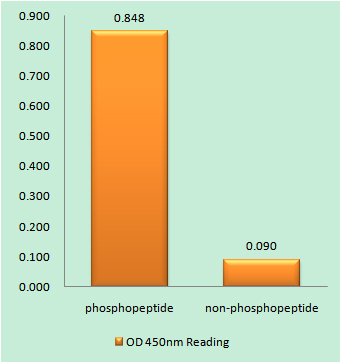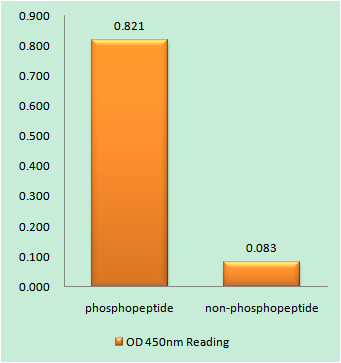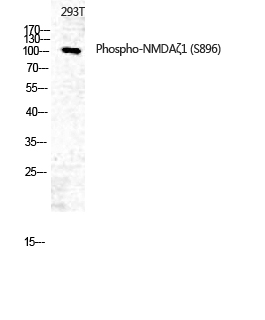Phospho NMDAR1 (S897) Cell-Based Colorimetric ELISA Kit
- Catalog No.:KA1624C
- Applications:ELISA
- Reactivity:Human;Mouse;Rat
- Gene Name:
- GRIN1
- Human Gene Id:
- 2902
- Human Swiss Prot No:
- Q05586
- Mouse Swiss Prot No:
- P35438
- Rat Swiss Prot No:
- P35439
- Storage Stability:
- 2-8°C/6 months
- Other Name:
- Glutamate [NMDA] receptor subunit zeta-1 (N-methyl-D-aspartate receptor subunit NR1) (NMD-R1)
- Detection Method:
- Colorimetric
- Background:
- function:NMDA receptor subtype of glutamate-gated ion channels with high calcium permeability and voltage-dependent sensitivity to magnesium. Mediated by glycine. This protein plays a key role in synaptic plasticity, synaptogenesis, excitotoxicity, memory acquisition and learning. It mediates neuronal functions in glutamate neurotransmission. Is involved in the cell surface targeting of NMDA receptors.,online information:NMDA receptor entry,PTM:NMDA is probably regulated by C-terminal phosphorylation of an isoform of NR1 by PKC. Dephosphorylated on Ser-897 probably by protein phosphatase 2A (PPP2CB). Its phosphorylated state is influenced by the formation of the NMDAR-PPP2CB complex and the NMDAR channel activity.,similarity:Belongs to the glutamate-gated ion channel (TC 1.A.10) family.,subcellular location:Enriched in post-synaptic plasma membrane and post-synaptic densities.,subunit:Forms heteromeric channel of a zeta subunit (GRIN1), a epsilon subunit (GRIN2A, GRIN2B, GRIN2C or GRIN2D) and a third subunit (GRIN3A or GRIN3B); disulfide-linked. Found in a complex with GRIN2A or GRIN2B, GRIN3A or GRIN3B and PPP2CB. Interacts with DLG4 and MPDZ.,
- Function:
- conditioned taste aversion, startle response, suckling behavior, response to amphetamine, regulation of transcription, DNA-dependent, regulation of transcription from RNA polymerase II promoter, ion transport, cation transport, calcium ion transport, cellular ion homeostasis, cellular calcium ion homeostasis, cellular metal ion homeostasis, cell surface receptor linked signal transduction, glutamate signaling pathway, cell-cell signaling, synaptic transmission, nerve-nerve synaptic transmission, sensory perception, behavior, learning or memory, learning, memory, long-term memory,mating behavior, mating, locomotory behavior, feeding behavior, visual behavior, chemosensory behavior, associative learning, adult locomotory behavior, olfactory learning, visual learning, response to radiation, response to light stimulus, response to abiotic stimulus, response to endogenous stimulus, positive r
- Subcellular Location:
- Cell membrane ; Multi-pass membrane protein . Cell junction, synapse, postsynaptic cell membrane . Cell junction, synapse, postsynaptic density . Enriched in postsynaptic plasma membrane and postsynaptic densities. .
- June 19-2018
- WESTERN IMMUNOBLOTTING PROTOCOL
- June 19-2018
- IMMUNOHISTOCHEMISTRY-PARAFFIN PROTOCOL
- June 19-2018
- IMMUNOFLUORESCENCE PROTOCOL
- September 08-2020
- FLOW-CYTOMEYRT-PROTOCOL
- May 20-2022
- Cell-Based ELISA│解您多样本WB检测之困扰
- July 13-2018
- CELL-BASED-ELISA-PROTOCOL-FOR-ACETYL-PROTEIN
- July 13-2018
- CELL-BASED-ELISA-PROTOCOL-FOR-PHOSPHO-PROTEIN
- July 13-2018
- Antibody-FAQs



